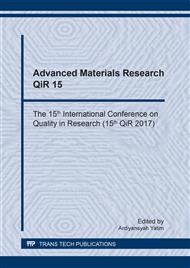p.171
p.177
p.186
p.191
p.200
p.209
p.218
p.225
p.234
Debinding Rate Enhancement of 17-4 Precipitation Hardening Stainless Steel Solvent Debinding on Metal Injection Molding Process as the Material for Orthodontic Bracket
Abstract:
Brackets fabrication should be done by a suitable process to produce great result. Processes commonly used are investment casting, machining, and metal injection molding. Investment Casting has a drawback in which the surface roughness is quite high for the standard of brackets and require further processing. Machining is done by removing unwanted part to get desire shape, whereas bracket shape requires a high accuracy and is quite complicated. In Metal Injection Molding, feedstock is injected into a mold where complicated shapes can be achieved with a better surface roughness. The weakness is the stages within the process are quite long. One of the problem is the efficiency of debinding stage. We conducted an experiment to enhance binder removal rate through solvent debinding with stirring and under vacuum condition. Sample use for this experiment is a cubic shape of 0.5 x 0.5 x 0.5 cm3. Experiment is done on magnetic stirrer and in vacuum furnace. The temperature is hold at 50°C. Drying process afterward is done in the vacuum furnace for 1 hour with temperature around 50°C. Amount of binder left is confirmed by STA and the particle morphology is seen by SEM. Results showed that stirring treatment enhances binder removal rate due to stirring mechanism that causes possibility of collisions between particles increases. Binder removal rate on the vacuum treatment has a mechanism similar to stirring, but with the addition of the solvent to be done on a regular basis due to decrease of solvent boiling point under vacuum. There were no cracks found on the surface with an increased rate of debinding. Stirring is use for experiment with sample of actual bracketorthodontic form. Debinding rate of the bracket sample is faster than the cubic sample. This result is affected by the dissimilarity on the volume to surface area.
Info:
Periodical:
Pages:
200-208
Citation:
Online since:
August 2018
Price:
Сopyright:
© 2018 Trans Tech Publications Ltd. All Rights Reserved
Share:
Citation:


